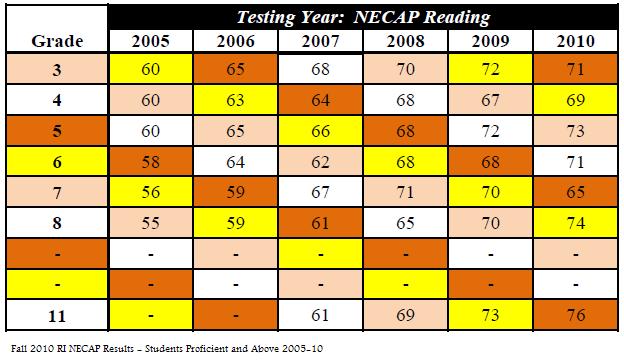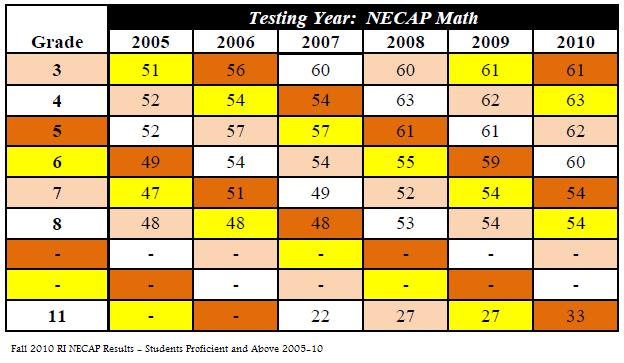Rhode Island NECAP Trends
Previously, I focused on tracking the NECAP results of one cohort of kids as the moved through the Warwick School system (to 11th grade). What I found was that reading and writing continued to improve, while math went in the opposite direction. I took this–cautiously–as good news as does Julia Steiny, with the usual caveats:
C’mon, it’s a big deal that Rhode Island’s high-schoolers pulled ahead of our two sister states in the New England Common Assessment Program (NECAP). In reading, R.I. juniors kicked butt, scoring 76 percent proficient, besting Vermont’s 72 and New Hampshire’s 74 percent. In writing, our teens were 51 percent proficient, edging out Vermont’s 50 and New Hampshire’s 45….please, I know tests are not the be-all, end-all. But doing well is promising. I think of watching test scores as comparable to watching one’s weight. The number says nothing about the quality of life, talent, or character, but it’s a major indicator of overall health.
So for example, the last reports by the National Assessment of Educational Progress (NAEP) showed that all three of the NECAP states’ fourth and eighth graders made significant progress. Only one other state and Washington, D.C., also did so. So working toward success on the NECAPs helps kids learn and perform no matter what the test. That’s huge.
Steiny also mentioned the charts that show cohort trends for all Rhode Island students that the ProJo printed in concert with Jennifer Jordan’s February 10 story on the NECAP results. These charts weren’t in the online edition–at least not that I could find–but (again, as Steiny points out) they are available at the RI Dept of Ed. website in it’s Fall 2010 NECAP Report (PDF). It’s worth taking a look at them given my belief that there is just as much–if not more–value in tracking cohorts as there is in comparing them year-to-year.


There were no writing results because it’s a newer test, but comparing the previous data from Warwick to statewide cohort tracking reveals (unsurprisingly) the same sort of trend. Basically, each cohort is improving in Reading from year-to-year and getting worse in math (remember–this is according to the NECAP test standards for each grade level). It also looks like the test scores for each grade–as one cohort replaces another at a particular grade level–have continually improved. Though it does look like Math scores seem to have plateaued, particularly at the younger levels. This comparison could be more indicative of pedagogy and show that schools may need to freshen up their approach to math so they can get over the hump.

Hey, how did all those charter schools do on the NECAP?
So NECAP scores are as good a predictor of quality education as your weight is for health? You would think that would be easy to show, wouldn’t you? I say it’s more like measuring height and then claiming a connection to better healthm maybe even cancelling your daily trip to the gym so you can spend more time practicing measuring your height.
It’s funny how people like Russ and the Seagull always want to criticize things like the testing but never offer a solution.
So let’s say we throw out the testing and let the teachers teach. How do we evaluate what kind of a job they’re doing? How do we know that students are learning what they need to know?
Suggestions? Crickets?
First off, if it can be shown that we are doing something demonstrably harmful it is enough to say stop doing it. To paraphrase Eric Scholtes, it’s like pointing out that we’re beating our heads against a wall and being asked but if we remove the wall what will we beat our heads against?
I’ve posted many, many times what to do. Start by reading W. Edwards Deming (plan, do, check, act).
Correction, Peter Scholtes. Unfortunately the Scholtes article I’d like to share is no longer available online. May finally force me to buy his book!
http://www.pscholtes.com/pscholtes/performance/
What Scholtes said to do instead is to decouple what it is we are trying to acheive (educate students, incent educators, improve schools, etc.) and to address each individually with continuous improvement (plan, do, check, act).